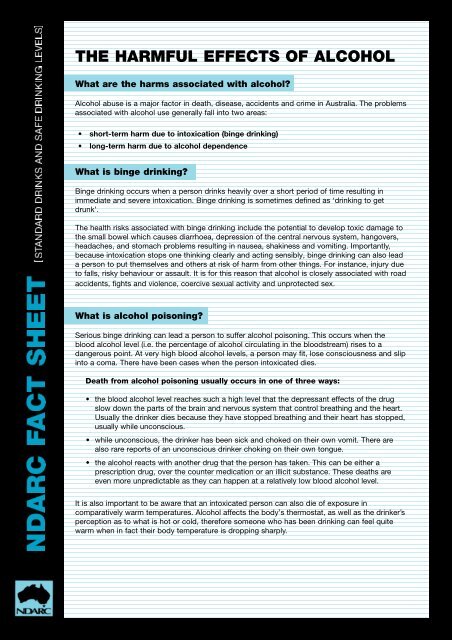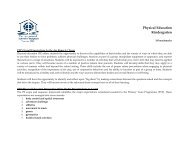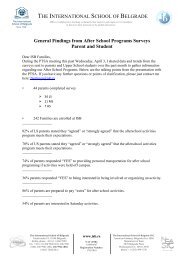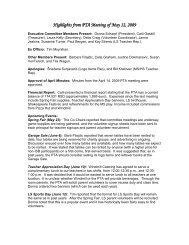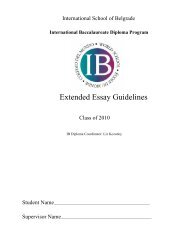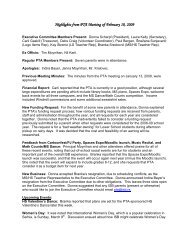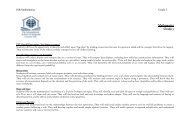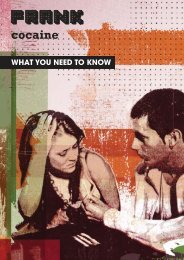THE HARMFUL EFFECTS OF ALCOHOL
THE HARMFUL EFFECTS OF ALCOHOL
THE HARMFUL EFFECTS OF ALCOHOL
Create successful ePaper yourself
Turn your PDF publications into a flip-book with our unique Google optimized e-Paper software.
<strong>THE</strong> <strong>HARMFUL</strong> <strong>EFFECTS</strong> <strong>OF</strong> <strong>ALCOHOL</strong>What are the harms associated with alcohol?Alcohol abuse is a major factor in death, disease, accidents and crime in Australia. The problemsassociated with alcohol use generally fall into two areas:• short-term harm due to intoxication (binge drinking)• long-term harm due to alcohol dependenceWhat is binge drinking?Binge drinking occurs when a person drinks heavily over a short period of time resulting inimmediate and severe intoxication. Binge drinking is sometimes defined as ‘drinking to getdrunk’.The health risks associated with binge drinking include the potential to develop toxic damage tothe small bowel which causes diarrhoea, depression of the central nervous system, hangovers,headaches, and stomach problems resulting in nausea, shakiness and vomiting. Importantly,because intoxication stops one thinking clearly and acting sensibly, binge drinking can also leada person to put themselves and others at risk of harm from other things. For instance, injury dueto falls, risky behaviour or assault. It is for this reason that alcohol is closely associated with roadaccidents, fights and violence, coercive sexual activity and unprotected sex.What is alcohol poisoning?Serious binge drinking can lead a person to suffer alcohol poisoning. This occurs when theblood alcohol level (i.e. the percentage of alcohol circulating in the bloodstream) rises to adangerous point. At very high blood alcohol levels, a person may fit, lose consciousness and slipinto a coma. There have been cases when the person intoxicated dies.Death from alcohol poisoning usually occurs in one of three ways:• the blood alcohol level reaches such a high level that the depressant effects of the drugslow down the parts of the brain and nervous system that control breathing and the heart.Usually the drinker dies because they have stopped breathing and their heart has stopped,usually while unconscious.• while unconscious, the drinker has been sick and choked on their own vomit. There arealso rare reports of an unconscious drinker choking on their own tongue.• the alcohol reacts with another drug that the person has taken. This can be either aprescription drug, over the counter medication or an illicit substance. These deaths areeven more unpredictable as they can happen at a relatively low blood alcohol level.It is also important to be aware that an intoxicated person can also die of exposure incomparatively warm temperatures. Alcohol affects the body’s thermostat, as well as the drinker’sperception as to what is hot or cold, therefore someone who has been drinking can feel quitewarm when in fact their body temperature is dropping sharply.
How do you know if a person is just drunk or suffering fromalcohol poisoning?If you see any one of the following, you should seek emergency medical help immediately– this is not something you can deal with alone:• the person is unconscious and can’t be awakened by pinching, prodding or shouting.• the skin is cold, clammy, pale, and bluish or purplish in colour, indicating that the person isnot getting enough oxygen.• the person is breathing very slowly; if there are more than 10 seconds between eachbreath – this is an emergency.• the person is vomiting without waking up.What is alcohol dependence?While drinking a small amount of alcohol is generally not harmful for most people, regulardrinking of a lot of alcohol can cause health, personal and social problems for a person over thelong-term.People who drink heavily may become dependent on alcohol. There are degrees of dependence,from mild dependency to compulsive drinking (often referred to as ‘alcoholism’). Alcoholdependence can be a physical problem, or psychological, or both.For instance, to some degree many of us are psychologically dependent on alcohol if we feelthat we cannot socialise at a party without a drink. In the case of an alcoholic person who isboth physically and psychologically dependent, alcohol becomes central to their life. Such aperson would suffer withdrawal symptoms such as, tremor, nausea, anxiety, depression,sweating, headache and difficulty sleeping, if they were to try to stop drinking or to cut down theamount they drink.How many people are at risk of harm from alcohol?According to the 2001 National Drug Household Survey about one-third (34.4%) of Australiansaged 14 years and over put themselves at risk of alcohol-related harm in the short term on atleast one drinking occasion during the 12 months prior to the survey.The Survey also found that:• one in eight people admitted to driving a motor vehicle while under the influence ofalcohol. Men (18.0%) were almost twice as likely as women (7.7%) to drive while underthe influence.• people in the 20-29 years age group were the most likely to consume alcohol in a way thatput them at risk for long-term (chronic) alcohol-related harm. This age group was also theleast likely to abstain from consuming alcohol.• there were over four million victims of alcohol-related verbal abuse and a further two millionAustralians aged 14 years or over were ‘put in fear’ by people under the influence ofalcohol in the 12 months prior to the survey. More than half a million Australians werephysically abused by people under the influence of alcohol.


